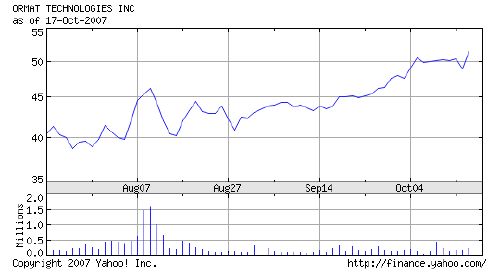
Over the past 3 months, Ormat (NYSE: ORA) market capitalization has increased to nearly $2B. The run up of the stock can be attributed to rumors that the company is considering some sort of takeover by private equity. The two names most closely connected to such potential deals are Goldman Sachs and Apax. Today, Apax has denied the rumors of such a deal.
What we do know is that a consolidation is underway in the renewable energy industry as established energy players rush to start or enhance their portfolios and renewable energy companies seek to cash-in on a liquidity event at near record market prices. This is a wise strategy, one only has to look at the ethanol segment today vs. two years ago to see how quickly and completely the bubble can pop. Caithness has provided a model for this, effectively exiting the operations of renewable power plants with the ArcLight Capital deal consummated earlier this year.
But what about valuation? Ormat is a $300M gross sales company split with 80% coming from electricity generation and 20% from equipment sales. Net income trailing 12 months is $21M and current market cap is $2B, 100x earnings value. Wow. The company carries nearly $500M in debt and has $73M in cash. The generation portfolio is around 370MW today and could double in the next 5-7 years, though it would be interesting to see how the company would choose to finance such aggressive expansion.
As a point of comparison, Calpine (OTC: CPNLQ.PK) has a geothermal portfolio of 800MW, development potential to increase that by 500MW over the next 5-7 years, and also has over 23,000MW of natural gas generation assets. Admittedly, Calpine is working to emerge from a painful and slow bankruptcy and does not have an equipment business as points of difference. Looking at the revenue, (though Calpine declines to segment revenues by gas fired and geothermal segments) we estimate that Calpine is capturing at least $400M per year in revenue from their geothermal portfolio and throwing off in excess of $100M per year in net income from the portfolio. Calpine’s market cap? $750M.
On the basis of this analysis, we would suggest that it would make more sense for large players looking to enter the renewable energy market in a big way to acquire Calpine, even at 100% premium of market price today, divest the natural gas resources and develop the other 500MW in Calpine’s pipeline. This would likely be more cost effective than taking on a smaller portfolio with an equipment business at a staggering premium. The bankruptcy proceedings definitely would complicate the matter, but it would be worth it to get such valuable assets without paying such a steep premium over intrinsic value.
Our analysis leads us to believe that Ormat is worth about $40/share presently, thus the current share price of $51.50 leads to substantial downside risk in the near to mid-term.
Disclosure: MeV holds no position in Ormat or Calpine. Tweet









Re: Caithness & ArcLight, a major difference btwn that & what may befall Ormat is that ArcLight has been intimately intwined w/Caithness for nearly a decade, while Ormat has no comparable partner.
Hi Art,
Thanks for the comment and that’s a very interesting observation. I didn’t know about the history between Caithness and ArcLight.
Thanks,
Mike
Mike, Thanks for the article. What price are you referring to as Calpines “market price today”? and paying 100% more for it.
Also, what did you mean by calpine “throwing off an exess of 100 m”? Is you implication that most of the profit is coming from the geysers?
Thanks
Craig
Craig,
Yesterday, when I wrote the piece the stock was trading at about $1.55/share, around a $750M market cap. I could imagine paying up to $1.5B for Calpine, disposing of the unprofitable natural gas generation business, starting further geothermal development, and reemerging as the largest pure-play renewable generation company in the country. (Yes, FPL has lots of wind and solar thermal, but the capacity factor on wind generously is 35% and solar thermal is 24%.) It wouldn’t be easy or simple, but it would be worthwhile. If I had access to that kind of cash, that’s what I’d do…
On the $100M comment, if you only factor the geothermal plants and take assumptions of an 800MW portfolio operating at 90% with a net power purchase price of $60/MWh (yes, you can get more, but Calpine’s PPAs are long in the tooth) you’ll get a gross revenue number of around $380+M for the geothermal portfolio. That’s likely an understated number. Factoring in debt service, O&M costs, and provision for income tax would leave net income in the $100M range, we think. These numbers aren’t broken out in Calpine’s reporting, but there are comparable performance metrics available which lead us to that conclusion.
Thanks for commenting, hope that answers your questions.